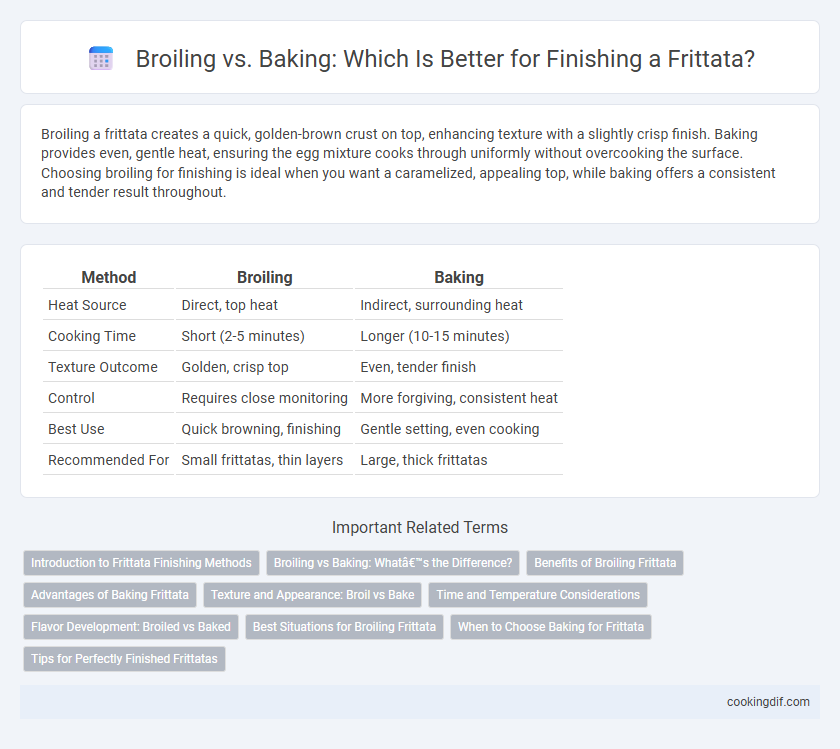Broiling a frittata creates a quick, golden-brown crust on top, enhancing texture with a slightly crisp finish. Baking provides even, gentle heat, ensuring the egg mixture cooks through uniformly without overcooking the surface. Choosing broiling for finishing is ideal when you want a caramelized, appealing top, while baking offers a consistent and tender result throughout.
Table of Comparison
| Method | Broiling | Baking |
|---|---|---|
| Heat Source | Direct, top heat | Indirect, surrounding heat |
| Cooking Time | Short (2-5 minutes) | Longer (10-15 minutes) |
| Texture Outcome | Golden, crisp top | Even, tender finish |
| Control | Requires close monitoring | More forgiving, consistent heat |
| Best Use | Quick browning, finishing | Gentle setting, even cooking |
| Recommended For | Small frittatas, thin layers | Large, thick frittatas |
Introduction to Frittata Finishing Methods
Finishing a frittata involves either broiling or baking, each method yielding distinct textures and flavors. Broiling quickly caramelizes the top, creating a golden, slightly crisp surface while keeping the inside tender and moist. Baking ensures even heat distribution, resulting in a uniformly cooked frittata with a soft, custard-like consistency throughout.
Broiling vs Baking: What’s the Difference?
Broiling and baking differ primarily in heat source and cooking time; broiling uses direct, high heat from above to quickly finish a frittata's top, creating a crisp, browned surface, while baking employs even, indirect heat from all sides for thorough, gentle cooking. Broiling typically takes just a few minutes, perfect for melting cheese and adding a golden crust, whereas baking can take 15-20 minutes, ensuring the entire frittata sets evenly. Choosing broiling over baking depends on desired texture and speed, making broiling ideal for a fast, crisp finish and baking best for even doneness throughout.
Benefits of Broiling Frittata
Broiling a frittata creates a perfectly golden, bubbly top while cooking the eggs more evenly and quickly than baking. The intense direct heat from the broiler crisps the edges and enhances texture, adding a delightful contrast to the creamy interior. This method saves time, making it ideal for achieving a restaurant-quality finish without overcooking the entire dish.
Advantages of Baking Frittata
Baking a frittata ensures even heat distribution, resulting in a uniformly cooked, tender, and fluffy texture. This method allows the egg mixture to set gently without the risk of burning or overcooking the top layer. The controlled environment of an oven provides consistent results, preserving the delicate flavors and moisture within the frittata.
Texture and Appearance: Broil vs Bake
Broiling a frittata creates a golden, slightly crisp top with a caramelized texture that enhances the visual appeal, while baking produces a more evenly cooked surface with a tender, custard-like consistency. Broiling finishes the dish quickly, promoting browning and slight charring for a textured contrast, whereas baking allows the frittata to set thoroughly and maintain a softer, uniform appearance. Choosing broil results in a visually striking, textured finish, while bake ensures a smooth, classic look with delicate firmness.
Time and Temperature Considerations
Broiling a frittata typically takes 2-4 minutes at a high temperature around 500degF, providing a quick, intense heat to brown the top rapidly. Baking requires a longer time, generally 15-20 minutes at 350degF, ensuring even cooking and a tender, fully set interior. Choosing between broiling and baking depends on desired texture, with broiling offering a crispy finish and baking delivering consistent doneness.
Flavor Development: Broiled vs Baked
Broiling a frittata enhances flavor development by creating a caramelized, slightly charred top that intensifies savory notes and adds depth through Maillard reactions. Baking, in contrast, provides even heat that gently cooks the frittata, preserving a tender texture and subtle flavors without the pronounced browning. Choosing broiling for finishing results in a more robust, toasted taste, while baking maintains a mellow, consistent flavor profile.
Best Situations for Broiling Frittata
Broiling a frittata is ideal for achieving a golden, crispy top quickly, especially when the eggs are fully cooked but the surface needs a finishing touch. This method works best for smaller frittatas or portions where intense direct heat can create a desirable texture without overcooking the interior. Broiling is preferred when you want a visually appealing, slightly browned finish in a matter of minutes, enhancing the dish's flavor and presentation.
When to Choose Baking for Frittata
Baking a frittata is ideal when aiming for an even, gentle cook that ensures the eggs set uniformly without over-browning the top. This method is preferred for thicker frittatas or when incorporating dense ingredients like potatoes or vegetables, as it allows heat to penetrate evenly and cook the interior fully. Choose baking when you want a tender texture and a consistent finish throughout the dish.
Tips for Perfectly Finished Frittatas
Broiling a frittata offers a quick, high-heat method to achieve a golden, bubbly top, ideal for when time is limited, but requires careful monitoring to avoid burning. Baking ensures even cooking throughout, producing a tender and uniformly set texture, best for thicker frittatas or ingredient-heavy versions. For perfect results, start cooking on the stove, then finish with either broiling for crispiness or baking for softness, depending on the desired crust and consistency.
Broiling vs Baking for finishing Infographic

 cookingdif.com
cookingdif.com